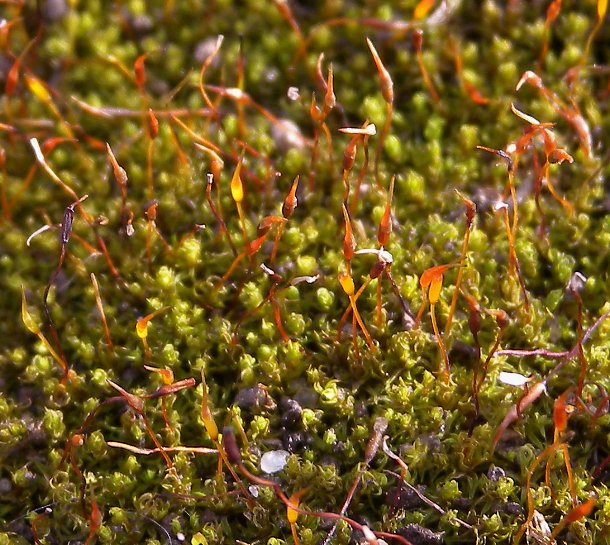
Because this moss is dioecious, male and female reproductive organs occur on separate plants; these reproductive organs are relatively inconspicuous. After fertilization occurs, sporophytes develop consisting of spore-bearing capsules on a relatively long stalks. The slender stalks (setae) are erect or ascending, straight or somewhat crooked, 1–2.5 cm. long, terete, and hairless; they are usually orange to red at maturity. At the apices of the stalks are more or less erect spore-bearing capsules with membranous hoods. The capsule bodies are nearly cylindrical in shape, but slightly broader at the base than the apex; they are about 1.5 mm. long, tapered at the base, and orange, red, or brown at maturity. The lids (opercula) of the capsule bodies have long narrow beaks (about 1 mm. long) and they are covered by membranous hoods (calyptra) that have even longer narrow beaks (about 1.5 mm. long). The beaks of these hoods are often tilted to one side. After the lids and hoods fall from the capsule bodies, long teeth are revealed that are orange to red and hair-like in appearance. These teeth spirally twist around each other, or they may appear more spreading and frayed. Sometimes these teeth are early-deciduous and they detach from the capsule bodies with the lids.
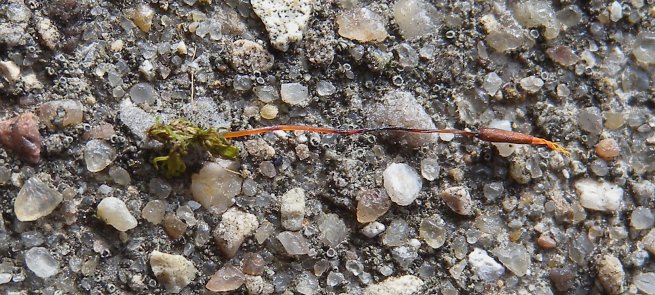
The spores of the capsules are released to the wind; this typically happens during late winter or spring. The spores are globoid in shape and very small in size (about 10 micrometers across). The plants are anchored to the substrate by fibrous rhizoids.
Cultivation: The preference is partial sun to moderate shade, moist to mesic conditions, and calcareous soil containing clay-loam or gravel. Most growth and development occurs during cool to cold moist weather from autumn to spring, including above-freezing winter days.
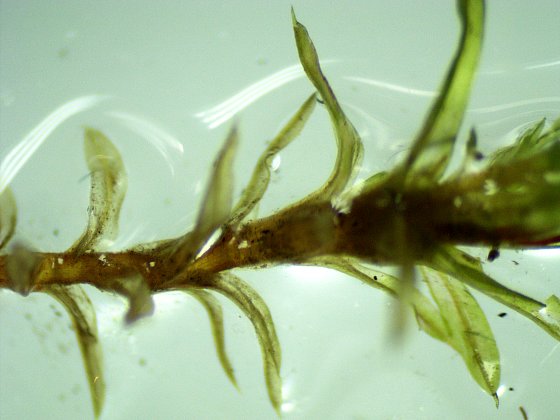
Range & Habitat: Common Beard Moss (Barbula unguiculata) is occasional to locally common in most areas of Illinois, although slightly more abundant in central and northern Illinois than southern Illinois (see Distribution Map). This moss is widely distributed in the United States and Canada, and it also occurs in Europe and other parts of the world. Common Beard Moss occurs in a wide variety of habitats in Illinois, including ground soil in sandy and non-sandy woodlands, shaded earthen banks, shallow soil of limestone outcrops, soil-filled cavities of limestone boulders along streams, sandy soil along streams, clay creek banks, gravelly ground along roads, shaded ground soil along buildings, cemetery grounds, old limestone quarries, soil-filled crevices of stone walls, soil-covered concrete abutments of bridges, gravelly bottoms of roadside ditches, burned ground of former campfire sites, mine spoils, dredge heaps from rivers, and moist ground of open disturbed areas. While this moss occurs sometimes in higher quality natural areas, it is more typical of disturbed habitats, especially where soil-covered limestone or concrete occurs.
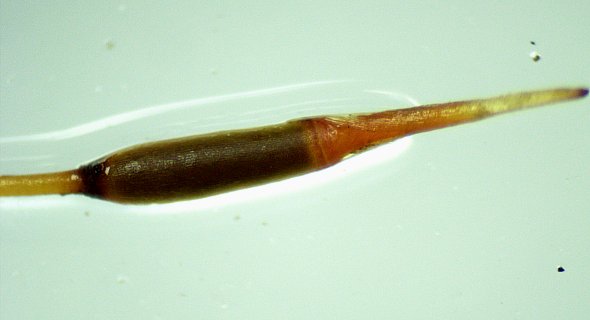
Faunal Associations: Records of floral-faunal relationships for this moss in North America have not been encountered, although the larvae of a moth, Catoptria falsella, and a groundhopper, Tetrix ceperoi, are known to feed on it in Europe.
Photographic Location: On ground soil along the north side of a building near shrubbery and a small tree in downtown Urbana, Illinois. Close-up photos were taken with a microscope indoors.
Comments: This is another obscure acrocarpous moss that can be found in a variety of habitats. It can be distinguished from most mosses by the long twisted hair-like teeth of its spore-bearing capsule bodies. These spirally twisted teeth resemble either miniature tornadoes or messy beards, and they probably account for the common name, Beard Moss (from Barbula). However, these teeth are also fragile and sometimes they fall off the capsule bodies rather easily.
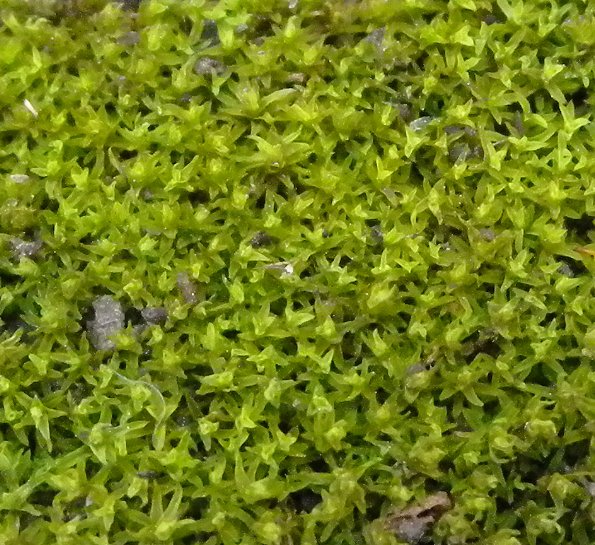
Another moss species in this genus, Barbula convoluta, is rarely found in Illinois. It differs by having shorter leaves (about 0.75–1.5 mm. long) that are more broadly oblong in shape and the margins of its leaves curve downward only toward the leaf bases. Both of these species have leaves that tend to taper abruptly to short narrow tips, although the tips of Common Beard Moss (Barbula unguiculata) are longer and more conspicuous. This moss also resembles some of the Tornado Mosses (Tortella spp.), especially Tortella humilis (Small Tornado Moss). Like Common Beard Moss, the spore-bearing capsules of Tornado Mosses have hair-like teeth that are spirally twisted, resembling miniature tornadoes. Small Tornado Moss differs from Common Beard Moss in having slightly longer leaves (2–3.5 mm. long) that taper more gradually toward their tips. The margins of these leaves are relatively flat, while the leaf margins of Common Beard Moss are down-turned. Under dry conditions, the leaves of Common Beard Moss are held erect, but they are also rather crisped and contorted in appearance. In contrast, the dry leaves of Small Tornado Moss (and other Tornado mosses) fold inward along their midribs and then curl, looking like miniature curved ropes. Another common name of Barbula unguiculata is Bird's Claw Beard Moss.